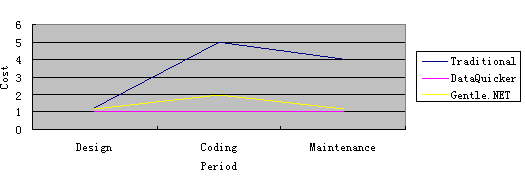Introduction
In any database application, the Data Access Layer takes part as a data agency between the database and the application. In .NET, usually we use ADO.NET in our DAL classes. However, DataQuicker extends the functionality and simplifies developing the Data Access Layer, and provides an efficient and simple framework to construct your application. Because of its structure, it’s very suitable for medium/small enterprise applications. Based on my past experience on DataQuicker, it’s convenient to build the MVC architecture with AJAX for web projects. As the Model part in MVC, it can reduce 40 percent work load at the least. (100% for DAL, 30% for business.) Because of its convenience, we can save energy for business design and coding, to pay more attention on the project design. For a company, this enables to provide our customers a perfect project on time. And for us (developers, testers, product managers and all project participators), it keeps us far away from overtime working or project delays.


DataQuicker supports transformation of data tables to the data access layer directly, and nearly needs no modification of code. Also, we can create validation expressions on a property of the DAL class by using the Validate classes. This will decrease your workload obviously. Besides the benefit in reduced durations, our project using DataQuicker is easy to maintain. Also, if we change the database schema, we only need to adjust the mapping DAL classes lightly.
Basically, I believe you can benefit from DataQuicker for free, and get a long term service and upgrade for new features.
History
- Version 0.9.4 Updates.
- Obvious improvements on configuration settings, and also on its mechanism. The enhancement includes:
- Plugged assembly support.
- Cryptography on password, supports an external plugged cryptographic assembly to use customized encrypt/decrypt arithmetic.
- Flexible configuration settings for connection string combination.
- Configuration cache and its change monitoring.
- Add a new column type support – binary. It allows your reading/writing image, file and any other binary data from/into database.
- Adopt a new constructor instead of all
CreateInstance methods defined in the DAL classes.
- Create provider factory to create provider object, and use a provider pool to cache provider objects. It’ll accelerate provider construction a lot.
- Version 0.9.2 Updates.
- Removed all query conditions setting on
FieldMapping/EntityMapping, but introduced a new class Query responsible for querying. So, in 0.9.2, we must refer to class Query for querying. It supports most aggregate functions and group-by clauses better than now. And it's possible to combine any SQL for your purpose.
- Changed the habit of operation, completely obeys CRUD (create, retrieve, update, delete) in this new version, integrated the interface
IProvider.
- Improvements on the provider and the analyzer, uses
IDbCommand and IDataParameter. That's more secure and efficient than the old version. It can prevent all potential attacks and defects in combining SQL.
- Modifications on the DAL design. Basically, if we only use CRUD, there is no necessary to care about the association of tables/views. When querying, we can create associations between tables/views dynamically. Aso, we only need to create a persistence layer for each table/view at the most.
- Supports multiple primary keys, but unfortunately, DataQuicker cannot manage multiple primary keys automatically. We're only allowed to set the DataQuciker managed primary key for a single primary key.
- Improved the performance of common kit methods.
